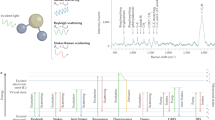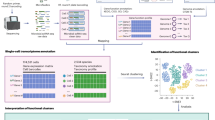Abstract
Stoichiometry of microbial biomass is a key determinant of nutrient recycling in a wide variety of ecosystems. However, little is known about the underlying causes of variance in microbial biomass stoichiometry. This is primarily because of technological constraints limiting the analysis of macromolecular composition to large quantities of microbial biomass. Here, we use Raman microspectroscopy (MS), to analyze the macromolecular composition of single cells of two species of bacteria grown on minimal media over a wide range of resource stoichiometry. We show that macromolecular composition, determined from a subset of identified peaks within the Raman spectra, was consistent with macromolecular composition determined using traditional analytical methods. In addition, macromolecular composition determined by Raman MS correlated with total biomass stoichiometry, indicating that analysis with Raman MS included a large proportion of a cell's total macromolecular composition. Growth phase (logarithmic or stationary), resource stoichiometry and species identity each influenced each organism's macromolecular composition and thus biomass stoichiometry. Interestingly, the least variable peaks in the Raman spectra were those responsible for differentiation between species, suggesting a phylogenetically specific cellular architecture. As Raman MS has been previously shown to be applicable to cells sampled directly from complex environments, our results suggest Raman MS is an extremely useful application for evaluating the biomass stoichiometry of environmental microorganisms. This includes the ability to partition microbial biomass into its constituent macromolecules and increase our understanding of how microorganisms in the environment respond to resource heterogeneity.
Similar content being viewed by others
Log in or create a free account to read this content
Gain free access to this article, as well as selected content from this journal and more on nature.com
or
References
Amann RI . (1995). In situ identification of micro-organisms by whole cell hybridization with rRNA-targeted nucleic acid probes. Molecular Microbial Ecology Manual Akkeman ADC,, van Elsas JD, de Bruigin FJ Kluwer Academic Publishers: Dortrecht, 1–15.
Anderson MJ . (2001). A new method for non-parametric multivariate analysis of variance. Austral Ecol 26: 32–46.
Bradford MM . (1976). A rapid and sensitive method for the quantification of microgram quantities of protein utilizing the principle of protein-dye binding. Anal Biochem 72: 248–254.
Cherif M, Loreau M . (2009). When microbes and consumers determine the limiting nutrient of autotrophs: a theoretical analysis. Proc R Soc Lond B 276: 487–497.
Cotner JB, Makino W, Biddanda BA . (2006). Temperature affects stoichiometry and biochemical composition of Escherichia coli. Microb Ecol 52: 26–33.
Danger M, Oumarou C, Benest D, Lacroix G . (2007). Bacteria can control stoichiometry and nutrient limitation of phytoplankton. Funct Ecol 21: 202–210.
Danger M, Daufresne T, Lucas F, Pissard S, Lacroix G . (2008). Does Liebig's law of the minimum scale up from species to communities. Oikos 117: 1741–1751.
Daniels L, Hanson RS, Phillips J . (2007). Total carbohydrates by phenol reaction. Methods for General and Molecular Microbiology Reddy CA, Beveridge TJ, Breznak JA et al. Chemical Analysis ASM Press: Washington, D.C.
De Gelder J, Willemse-Rix D, Scholtes MJ, Sanchez JI, Maquelln K, Vandenabeele P et al. (2008). Monitoring Poly(3-hydroxydutyrate) production in Cupriavidus necator DSM 428 (H16) with Raman Spectroscopy. Anal Chem 80: 2155–2160.
De Gelder J, De Gussem K, Vandenabelle P, De Vos P, Moens L . (2007). Methods for extracting biochemical information from bacterial Raman spectra: an explorative study on Cupriavidus metallidurans. Analytica Chimica Acta 585: 234–240.
Elser JJ, Dobberfuhl DR, Mackay NA, Schampel JH . (1996). Organism size, life history, and N:P stoichiometry. BioScience 46: 674–684.
Elser JJ, Acharya K, Kyle M, Cotner JB, Makino W, Markow TA et al. (2003). Growth rate-stoichiometry couplings in diverse biota. Ecol Lett 6: 936–943.
Goral J, Zichy V . (1990). Fourier transform Raman studies of materials and compounds of biological importance. Spectrochim Acta 46A: 253–275.
Gorokhova E, Dowling TE, Weider LJ, Crease TJ, Elser JJ . (2002). Functional and ecological significance of rDNA intergenic spacer variation in a clonal organism under divergent selection for production rate. Proc R Soc Lond B 269: 2373–2379.
Hall EK, Dzialowski AR, Stoxen SM, Cotner JB . (2009). The effect of temperature on the coupling between phosphorus and growth in lacustrine bacterioplankton communities. Limnol Oceanogr 54: 880–889.
Howard WFJ, Nelson WH, Sperry JF . (1980). A resonance Raman method for the rapid detection and identification of bacteria in water. App Spectrosc 34: 72–75.
Huang WE, Stoecker K, Griffiths R, Newbold L, Daims H, Whiteley AS et al. (2007a). Raman-FISH: combining stable-isotope Raman spectroscopy and fluorescence in situ hybridization for the single cell analysis of identity and function. Environ Microbiol 9: 1878–1889.
Huang WE, Bailey MJ, Thompson IP, Whiteley AS, Spiers AJ . (2007b). Single-cell Raman spectral profiles of Pseudomonas fluorescence SBW25 reflects in vitro and in planta metabolic history. Microb Ecol 53: 414–425.
Huang WE, Griffiths R, Thompson IP, Bailey MJ, Whiteley AS . (2004). Raman microscopic analysis of single microbial cells. Anal Chem 76: 4452–4458.
Keiblinger KM, Hall EK, Szukics U, Haemmerle I, Ellersdorfer G, Sterflinger K et al. (2010). The effect of resource quantity and resource stoichiometry on microbial carbon use efficiency. FEMS Microbiol Ecol. doi:10.1111/j.1574-6941.2010.00913.x.
Kim S, Kaplan LA, Hatcher PG . (2006). Biodegradable dissolved organic matter in a temperate and a tropical stream determined from ultra-high resolution mass spectrometry. Limnol Oceanogr 51: 1054–1063.
Klausmeier CA, Litchman E, Daufresne T, Levin SA . (2004). Optimal nitrogen-to-phosphorus stoichiometry of phytoplankton. Nature 429: 171–175.
Kornberg A, Rao NN, Ault-Riche D . (1999). Inorganic polyphosphate: a molecule of many functions. Annu Rev Biochem 68: 89–125.
Legendre L, Legendre P . (2003). Numerical Ecology. Elsevier Science: Amsterdam.
Lopez-Amores R, Comas J, Garcia MT, Vives-Rego J . (1998). Use of the 5-cyano-2,3-ditolyl tetrazolium chloride reduction test to asses respiring marine bacteria and grazing effects by flow cytometry during linear alkylbenzene sulfonate degradation. FEMS Microbiol Ecol 27: 33–42.
Makino W, Cotner JB . (2004). Elemental stoichiometry of a heterotrophic bacterial community in a freshwater lake: implications for growth and resource dependent variations. Aquat Microb Ecol 34: 33–41.
Makino W, Cotner JB, Sterner RW, Elser JJ . (2003). Are bacteria more like plants or animals? Growth rate and resource dependence of bacterial C:N:P stoichiometry. Funct Ecol 17: 121–130.
Manzoni S, Jackson RB, Trofymow JA, Porporato A . (2008). The global stoichiometry of nitrogen mineralization. Science 321: 684–686.
Maquelin K, Kirschner C, Choo-Smith LP, van den Braak N, Endtz HP, Naumann D et al. (2002). Identification of medically relevant microorganisms by virbrational spectroscopy. J Microbiol Methods 51: 255–271.
Norland S, Fagerbakke K, Heldel M . (1995). Light element analysis of individual bacteria by X-ray microanalysis. Appl Environ Microbiol 61: 1357–1362.
Pérombelon MCM . (1980). Ecology of the soft rot Erwinias. Ann Rev Phytopathol 18: 361–387.
R-Development-Core-Team (2005). R: A language and environment for statistical computing, R Foundation for statistical computing. R-Development-Core-Team: Vienna, Austria.
Sangwan P, Chen X, Hugenholtz P, Janssen PH . (2004). Chthoniobacter flavus gen. nov., sp. nov., the first pure-culture representative of subdivision two, Spartobacteria classis nov., of the phylum Verrucomicrobia. Appl Environ Microbiol 70: 5875–5881.
Schinner F, Öhlinger R, Kandeler E, Margesin R . (1993). Bodenbiologische Arbeitsmethoden. Springer Labor: Berlin, Germany.
Schlesner H . (1987). Verrucomicrobium spinosum gen. nov., sp. nov,: a fimbriated prosthecate bacterium. System Appl Microbiol 10: 54–56.
Schuster KC, Reese I, Urlaub E, Gapes JR, Lendl B . (2000). Multidimensional information on the chemical composition of single bacterial cells by confocal Raman microspectroscopy. Anal Chem 72: 5529–5534.
Sterner RW, Elser JJ . (2002). Ecological stoichiometry: The biology of the elements from the molecules to the biosphere. Princeton University Press: Princeton, New Jersey.
Tilman DG . (1982). Resource competition and community structure. Princeton University Press: Princeton.
Wagner M . (2009). Single cell ecophysiology of microbes as revealed by Raman microspectroscopy or secondary ion mass spectrometry imaging. Annu Rev Microbiol 63: 411–429.
Acknowledgements
This study is a contribution from the research network MICDIF supported by the Austrian Research Fund (FWF) through Grants S10007-B17 to TB and S10002-B17 to HD The current version of this manuscript has been greatly improved by comments from G Kowalchuk and four anonymous reviewers.
Author information
Authors and Affiliations
Corresponding author
Additional information
Supplementary Information accompanies the paper on The ISME Journal website
Supplementary information
Rights and permissions
About this article
Cite this article
Hall, E., Singer, G., Pölzl, M. et al. Looking inside the box: using Raman microspectroscopy to deconstruct microbial biomass stoichiometry one cell at a time. ISME J 5, 196–208 (2011). https://doi.org/10.1038/ismej.2010.115
Received:
Revised:
Accepted:
Published:
Issue date:
DOI: https://doi.org/10.1038/ismej.2010.115
Keywords
This article is cited by
-
Niche partitioning of microbial communities in riverine floodplains
Scientific Reports (2019)
-
Specific carbonate–microbe interactions in the modern microbialites of Lake Alchichica (Mexico)
The ISME Journal (2013)
-
Tackling the minority: sulfate-reducing bacteria in an archaea-dominated subsurface biofilm
The ISME Journal (2013)
-
Rapid resonance Raman microspectroscopy to probe carbon dioxide fixation by single cells in microbial communities
The ISME Journal (2012)
-
Surface-enhanced Raman scattering (SERS) revealing chemical variation during biofilm formation: from initial attachment to mature biofilm
Analytical and Bioanalytical Chemistry (2012)



